Mother’s Day is just around the corner, falling on May 12th this year, and we have the best blooms to help you celebrate! Show Mom your appreciation with our exquisite selection of flowering hanging baskets, lilacs, annuals, and more. Plus, our full selection of roses including David Austins is now available! What says Mother’s Day better than roses? Keep reading below to see some of our favorite plants that are sure to WOW that special woman in your life this year.
1. LILACS
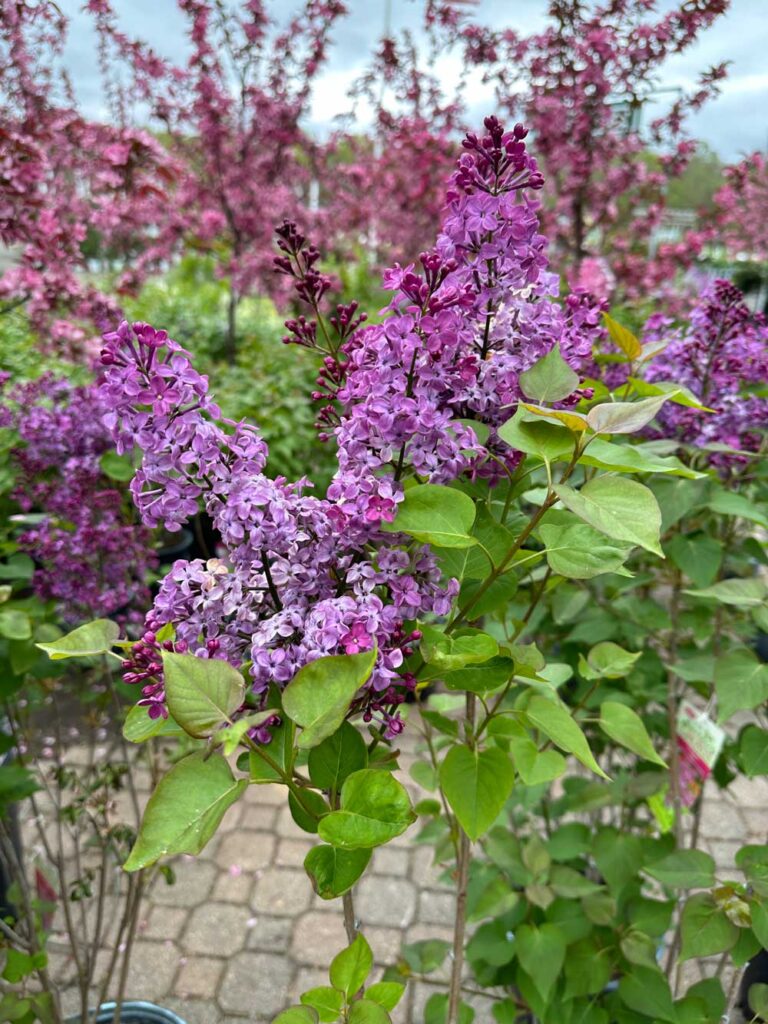
Lilacs bloom just in time for Mother’s Day, making them an obvious choice! With amazing fragrance and bright, full clusters of flowers, lilacs check all the boxes. Check out Pocahontas, a stunning early blooming variety (pictured above) with showy flowers that look great as cut flowers! Need one for a smaller space? We have a great selection of dwarf lilac including Baby Kim, a delightfully deer and disease-resistant variety, getting only about high 24-36″ at maturity!
2. ROSES
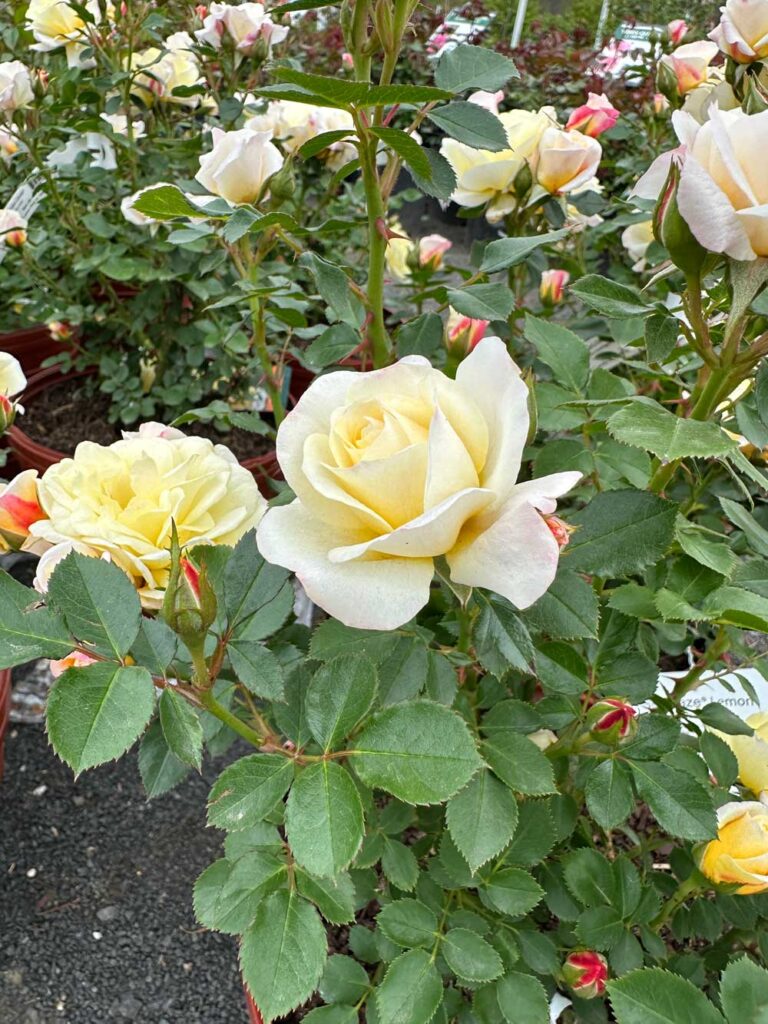
Browse our full selection of roses, now available! Choose from Knock Outs, Garden Roses, David Austins, and more in various colors and sizes. Surprise Mom with her favorite roses planted and ready to go in the garden.
3. ANNUAL MIXED CONTAINERS & BASKETS
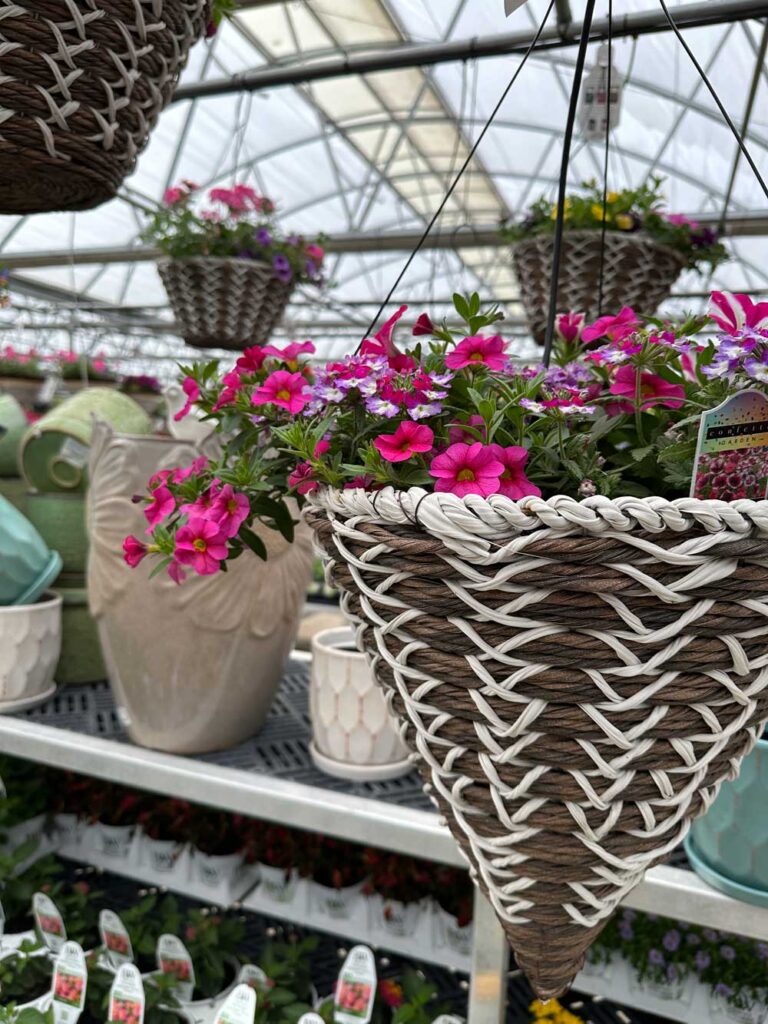
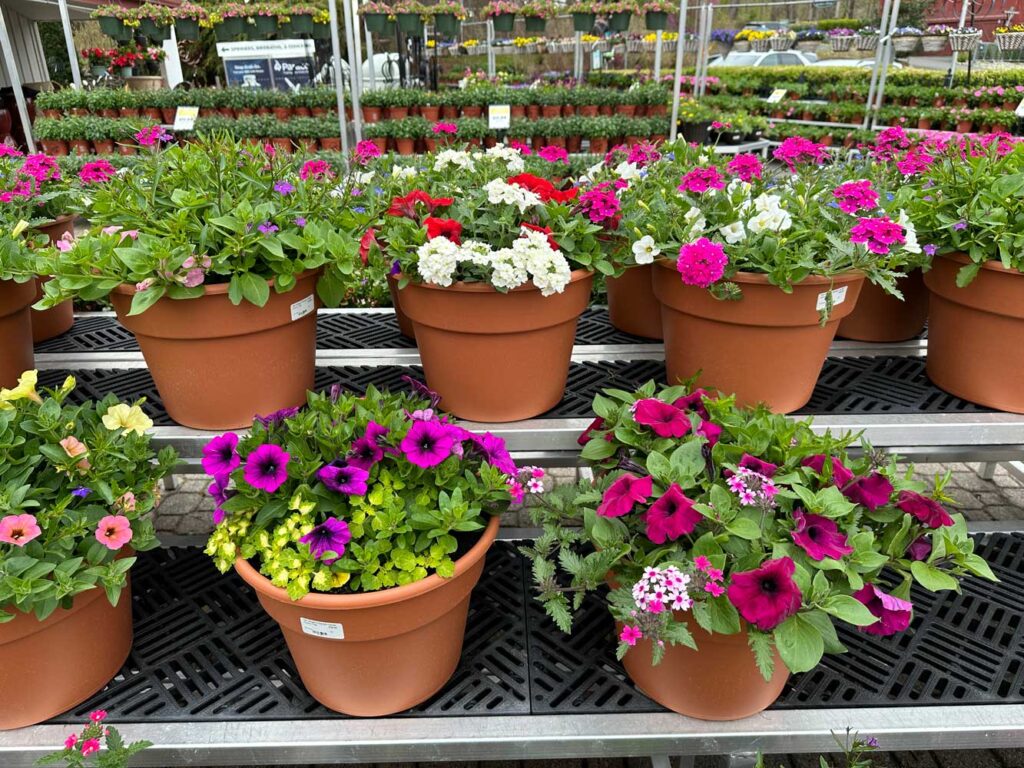
Grab gorgeous hanging baskets through Mother’s Day on sale two for just $80! Regularly $50 each. We also have some amazing annual combo pots ready for you that make perfect, hassle-free patio plants Mom will love.
4. FLOWERING VINES
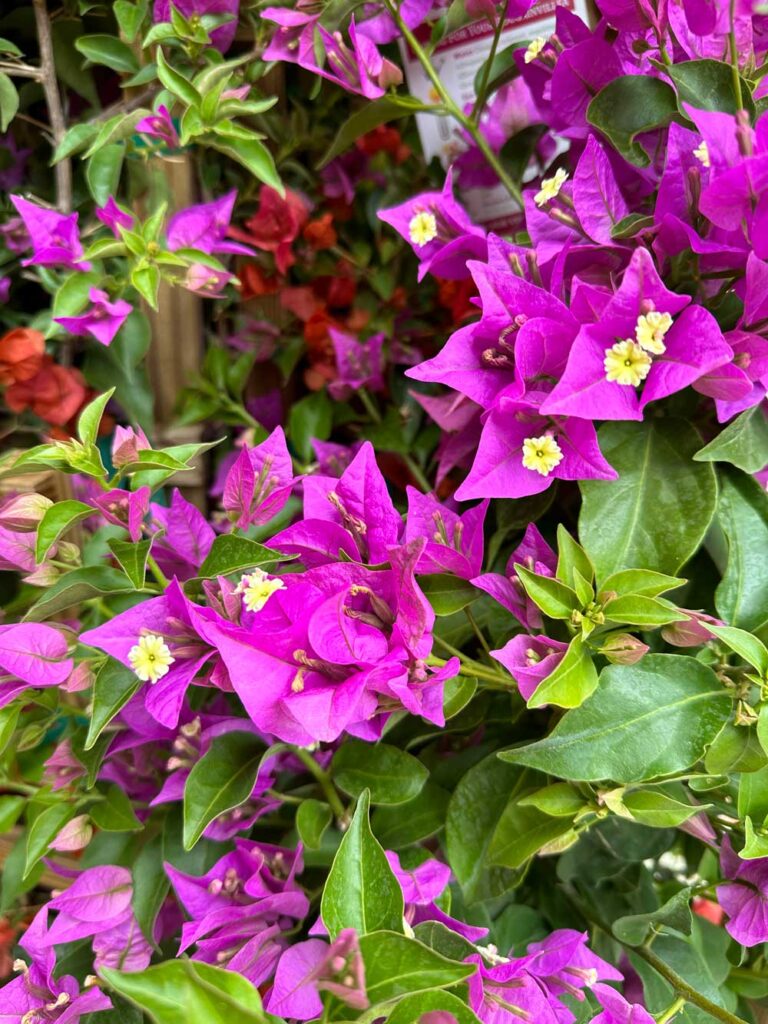
Bougainvillea: Tough as nails, fast-growing, and puts on a spectacular show of color. These vines are flowering machines that look great climbing a wall, sprawling as a groundcover on hillsides, or pruned and grown in containers.
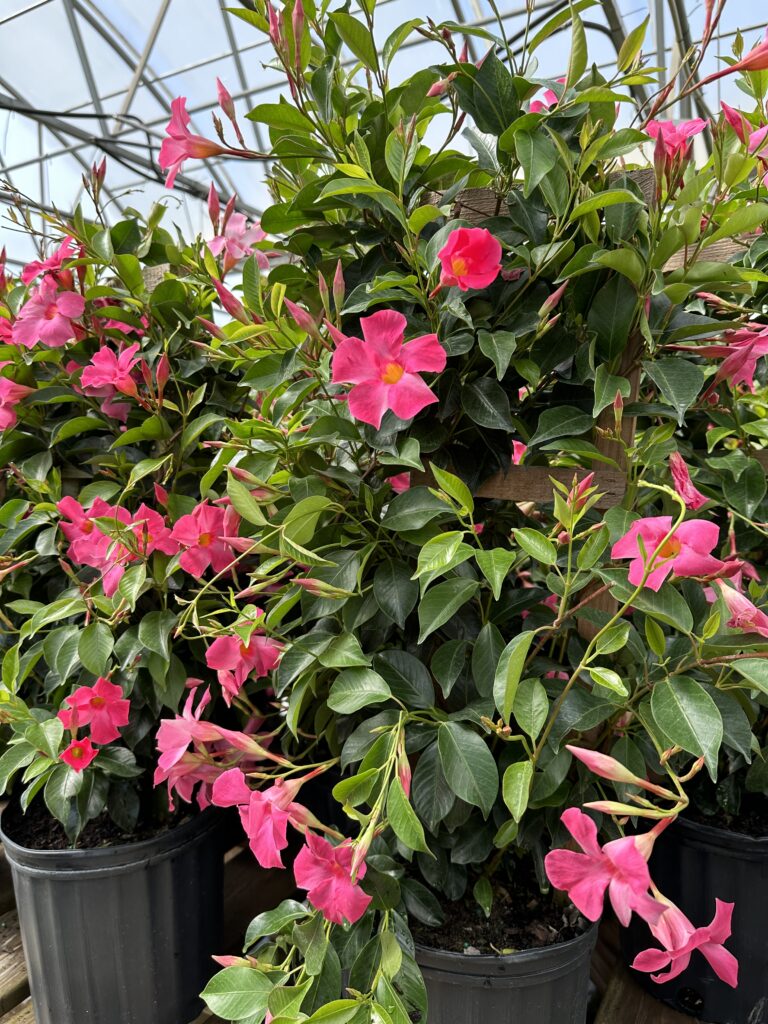
Mandevilla: Exotic trumpet-shaped flowers occur in colors of red, pink, white, or apricot. Plants bloom continuously from summer through fall! Very fast-growing and beautiful on trellises and spilling over in hanging baskets!
5. HOUSEPLANTS
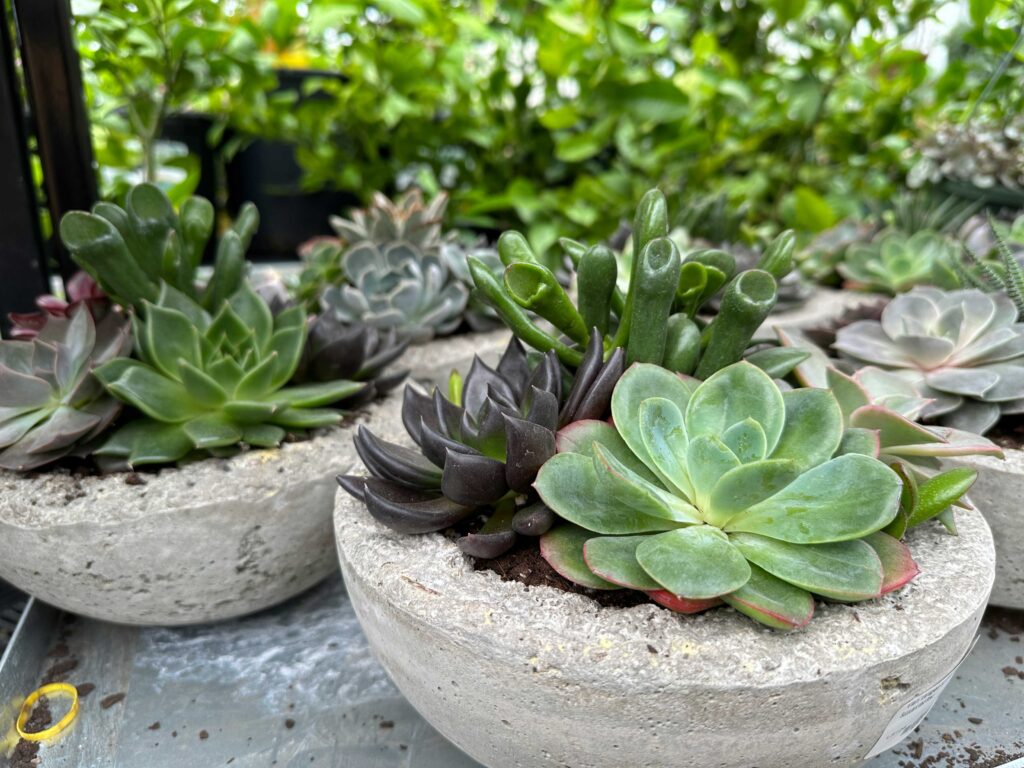
Just in… stunning succulent bowls! These beauties just arrived in a couple of different sizes and are an excellent low-maintenance houseplant option to bring life into any room.
OTHER GIFT IDEAS
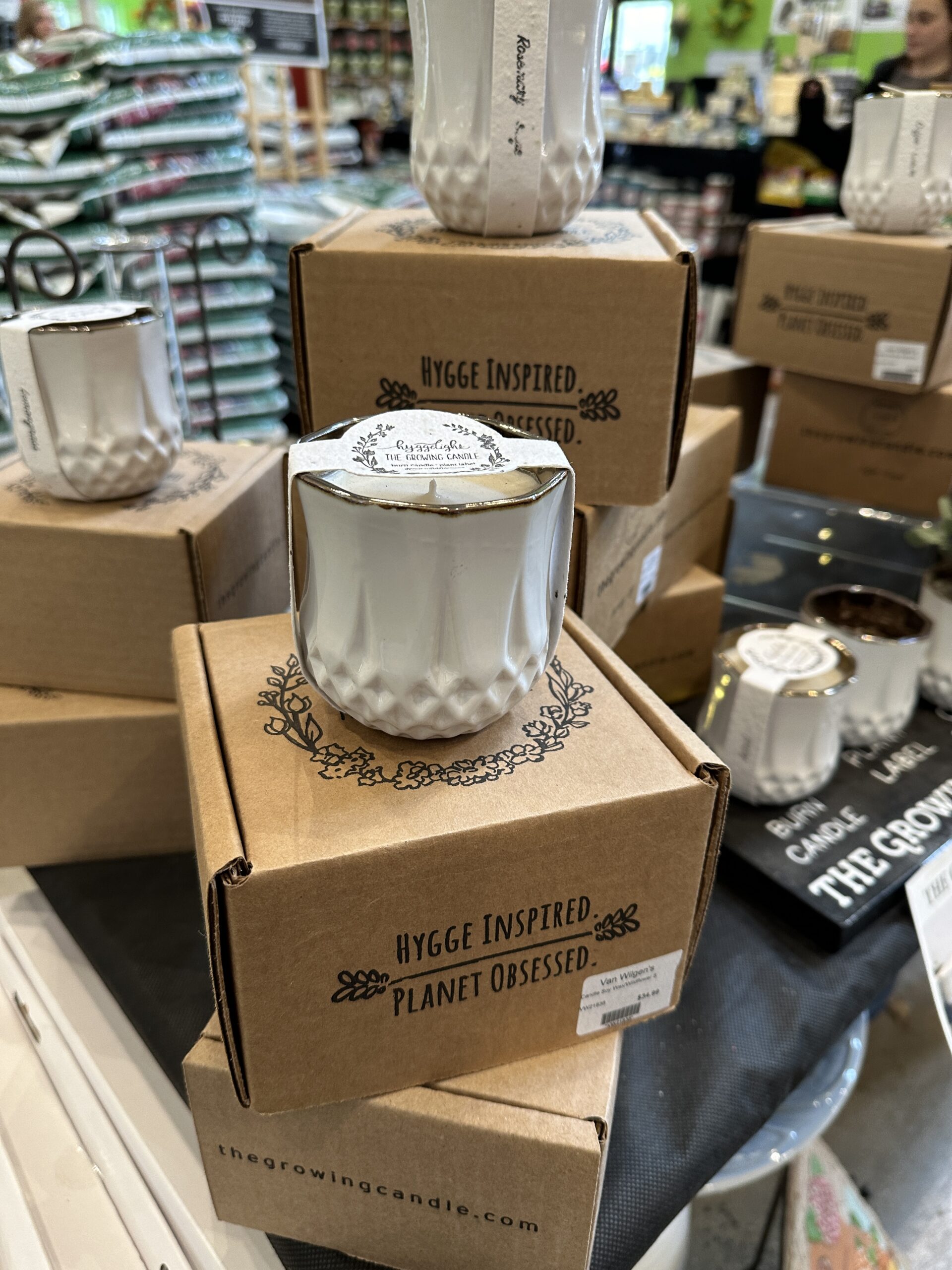
The Growing Candle: Get a gift that keeps on giving! With The Growing Candle, you’ll be giving more than just a scented candle. After you burn through the wax, you can plant the label and grow wildflowers! Choose from different designs and scents to customize this unique gift for that special plant lover in your life.
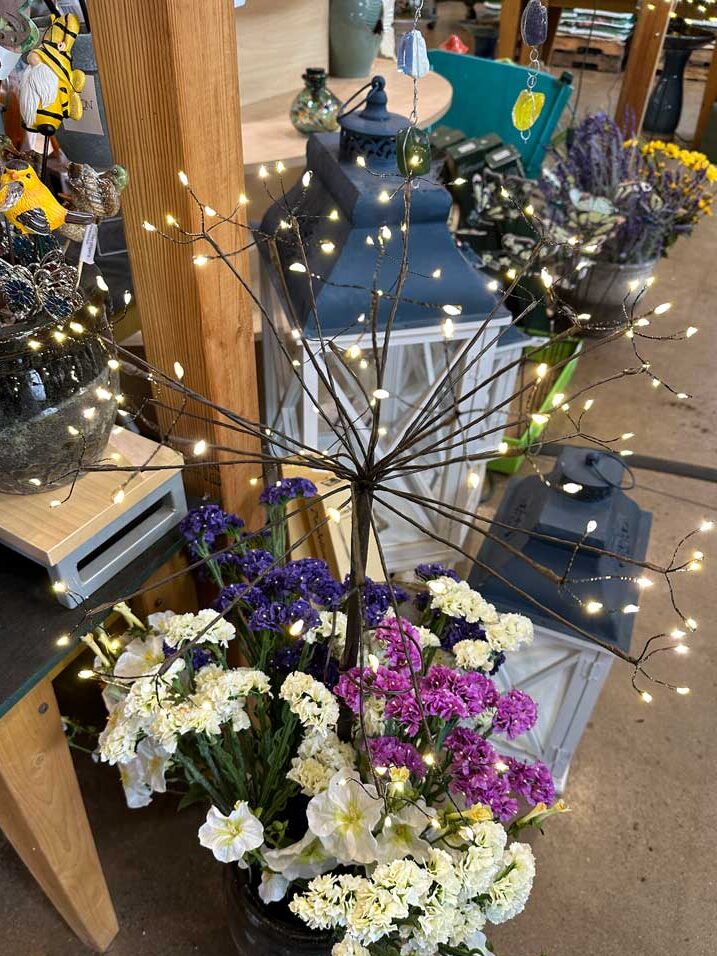
Dandelion Lights: This fun and popular take on string lights is super cute and makes an excellent decor piece for spring! Available in both solar and plug-in.
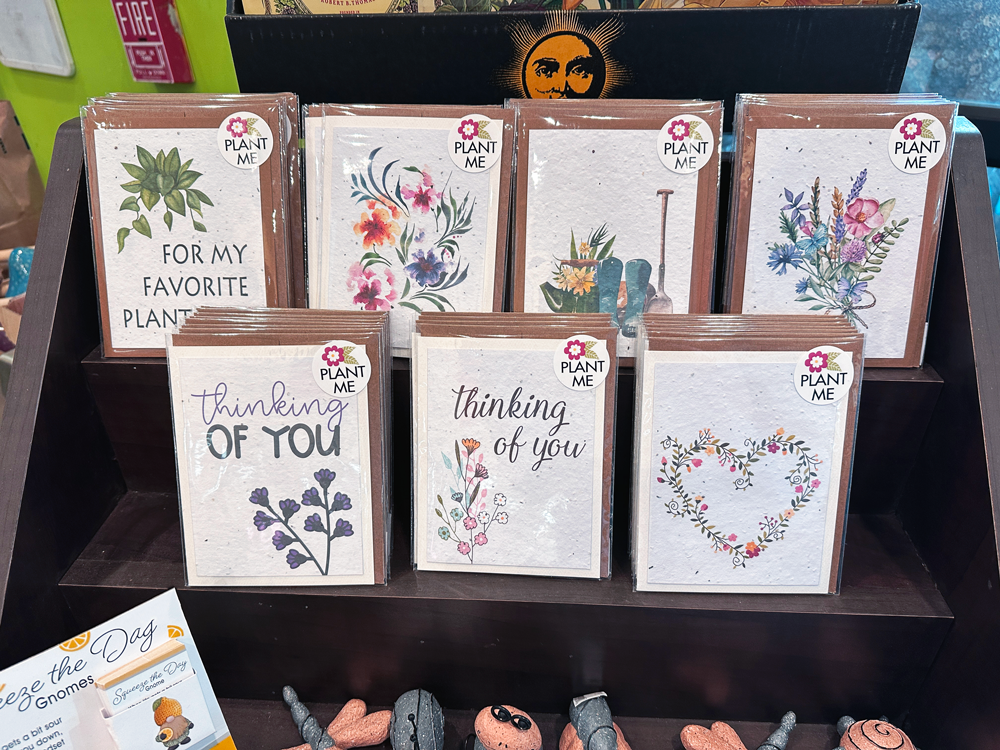
Plantable Cards: Give Mom a thoughtful card and gift all in one! Peel off the handcrafted seed paper from the front of the card, soak it in water overnight, plant it, and watch it grow into beautiful wildflowers.
Make a statement this Valentine’s Day with a unique gift! Flower arrangements are beautiful, but how long do they last? It’s time to swap out those cut flowers for a houseplant and say ‘I love you’ with stunning blooms that keep coming back, time and time again. Check out some of our favorite Valentine’s Day houseplants, as well as other fun gift ideas to bring out that spring mood.
Houseplants
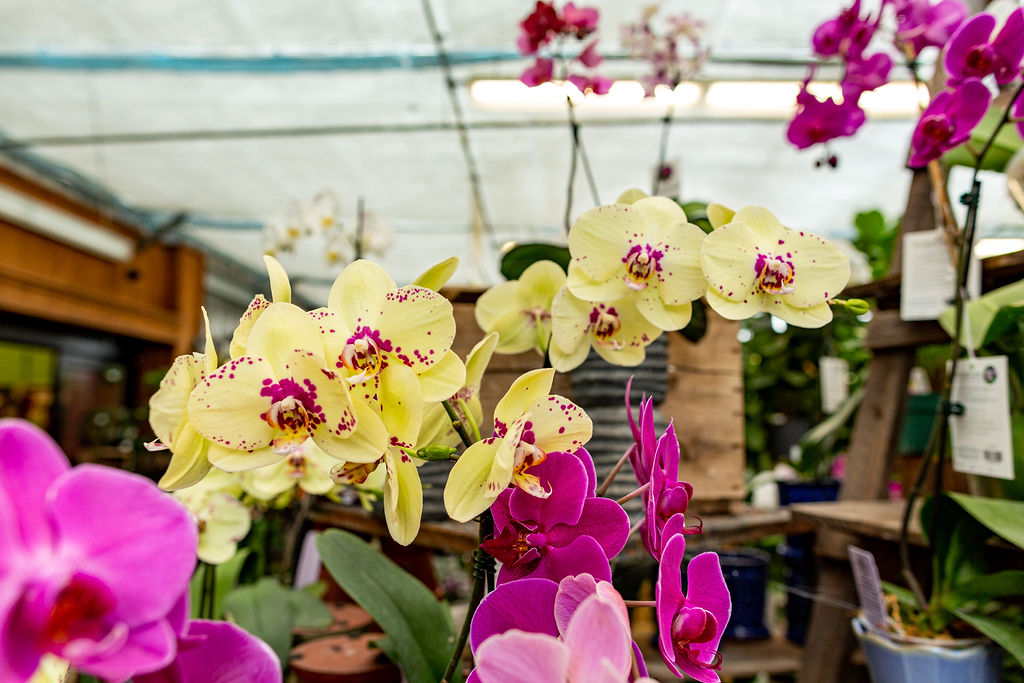
Orchids: If you are thinking of a quintessential flowering houseplant that comes in a multitude of colors–both solid and variegated–then you’ve come to the right place! Orchids can produce multiple flower spikes on one stem and with some fertilizer and pruning, they will flower every year.
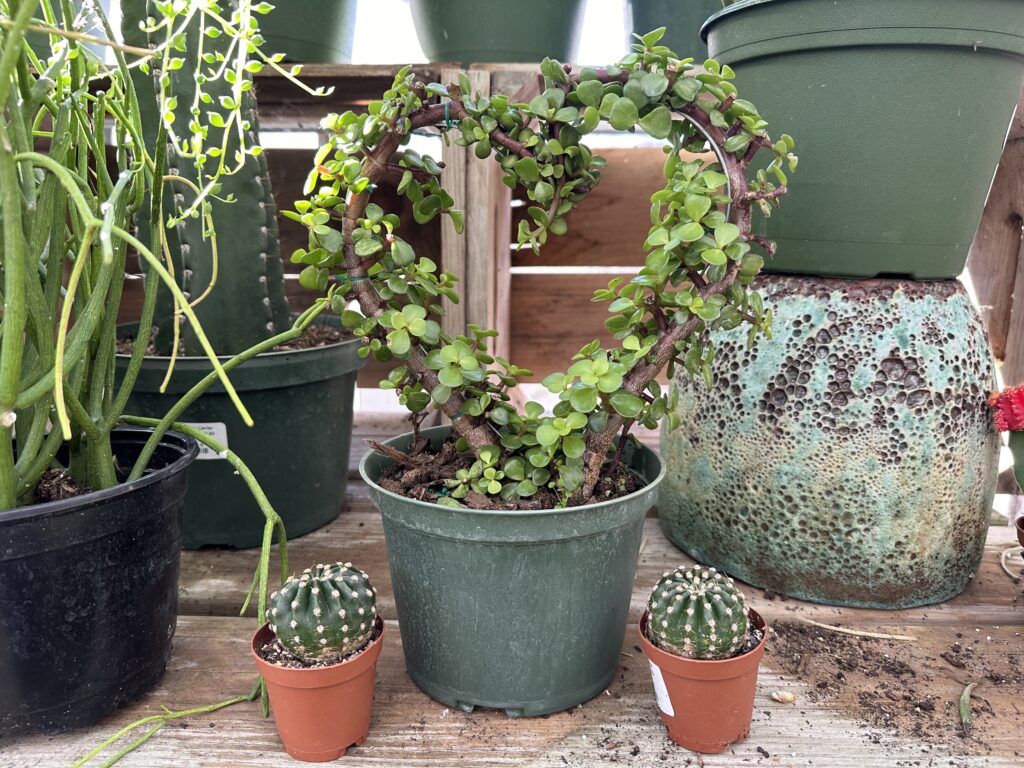
Jade Hearts: This one is sure to make a statement! These Jade plants grow around a heart-shaped trellis, making them a cute gift for the holiday of love. The perfect, easy-care succulent.
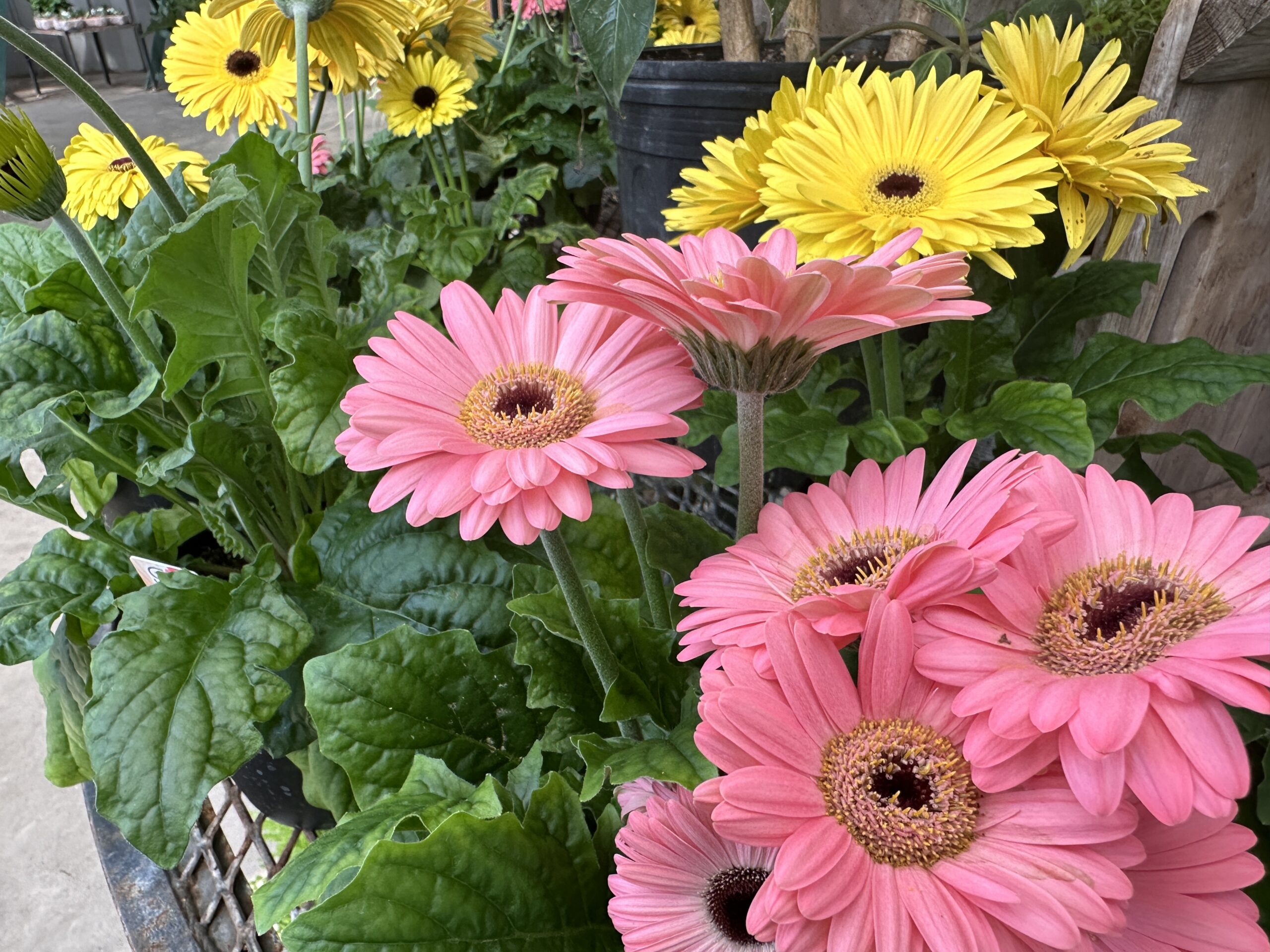
Gerbera Daisy: One might not consider daisies to be an indoor plant, but these sun-loving houseplants are extremely hardy to early spring indoor conditions and thrive on the windowsill. This plant’s flowers come in various warm colors like pink, orange, and red. These flowers will bloom until the harsh temperatures of the summer.
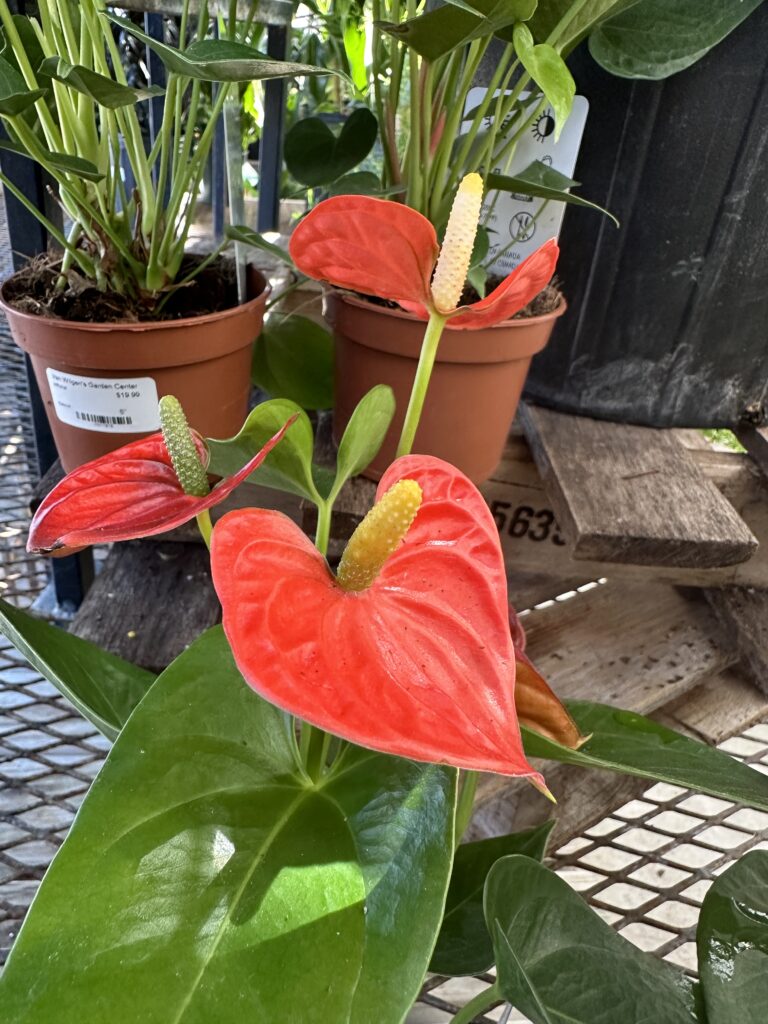
Anthurium: These bright red, heart-shaped leaves are sure to catch your eye! They bring a unique tropical feel to your space and are a great Valentine’s Day option. They are easy to care for but do like humidity, so be sure to mist them often!
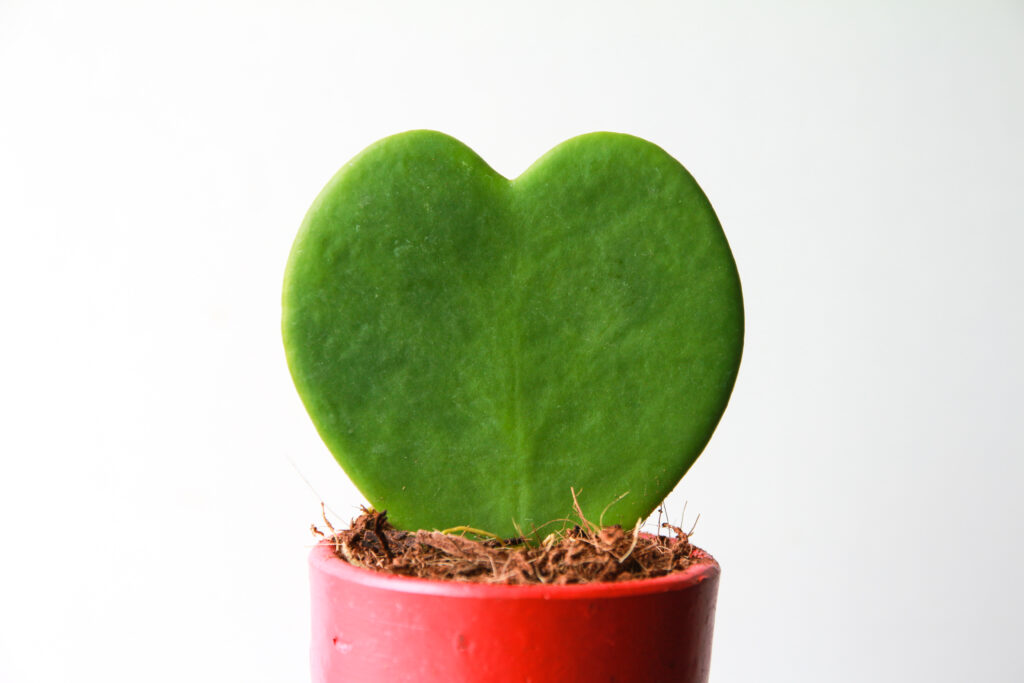
Valentine’s Day Hoya: Named for its heart-shaped leaves, this hoya is the perfect plant to represent the season of love. These hoya will continue to grow as time goes on and will produce new shoots and leaves. Eventually, this plant will resemble the traditional hoya shape and structure with longer vines draping over the pot’s edges.
OTHER GIFT IDEAS

Plantable Cards: Give your valentine a thoughtful card and gift all in one! Peel off the handcrafted seed paper from the front of the card, soak it in water overnight, plant it, and watch it grow into beautiful wildflowers.
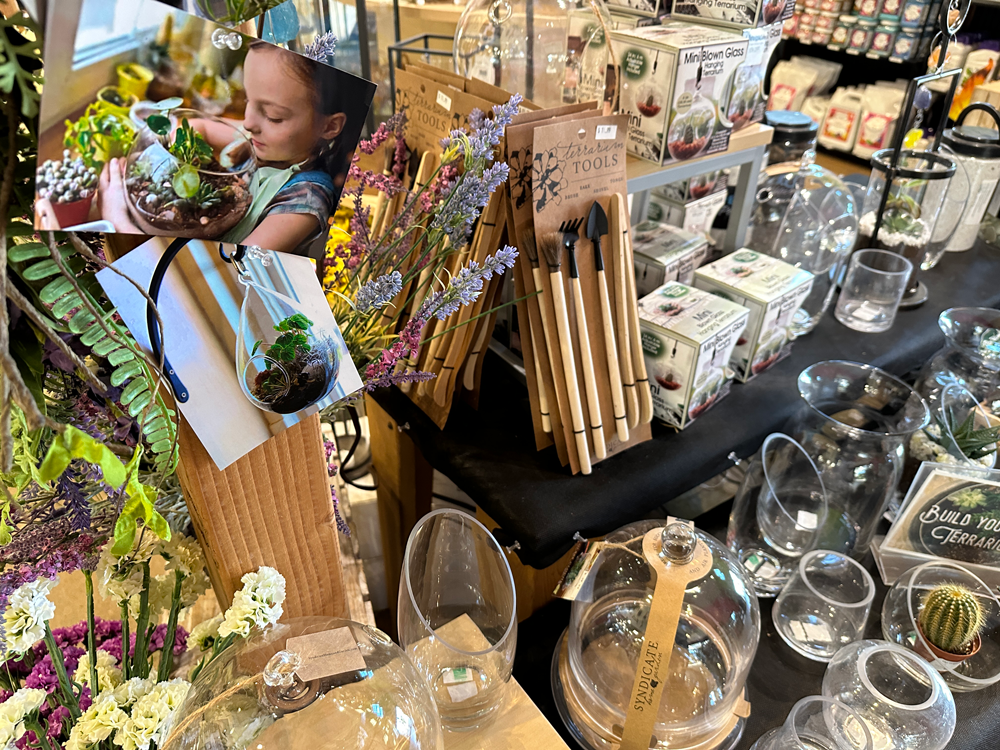
Terrarium: What’s better than a homemade gift? We have an extensive selection of products to create your terrarium. Hand-pick from containers, plants, and accessories to make a terrarium that the special someone in your life will love!
We hope to see you picking out some Valentine’s Day favorites soon!
You don’t need to wait for Spring to start a new planting project… terrarium building makes an excellent family activity or weekend project. Follow the steps below to get started today!
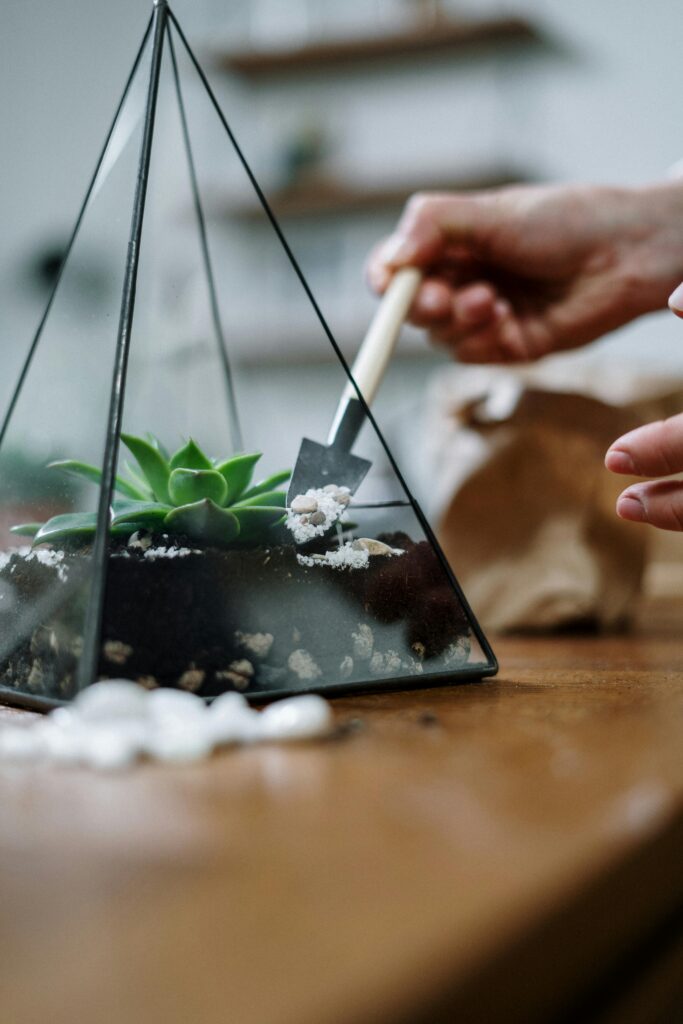
Step 1: Picking your Container
A good terrarium container is anything clear! Look for the perfect glass or plastic container that matches the decor of your home. The opening of the glass can be big or small, depending on what size plants you prefer to add.
Step 2: Constructing your Terrarium
The key to making a healthy environment in your terrarium is to work in layers.
- First, add 1/2-1″ of coarse sand, gravel, or pebbles. This is the drainage layer that will capture excess moisture.
- Add a thin layer of charcoal granules. Charcoal keeps odors from developing.
- Add a layer of Sphagnum Moss. Moss keeps soil from seeping into the drainage layer.
- Add 1/2-1″ of well-draining, fertile potting soil.
Step 3: Build your Terrarium
Begin by adding your preferred plants. Simply dig a small hole and use a spoon or mini shovel to cover the roots with soil. For a more interesting design, use an odd number of plants. this will heighten the organic nature of the terrarium. Try not to crowd the plants too much as they will grow into each other.
After you have added your plants, several different decorative options can be added to a terrarium to enhance the aesthetic you are going for. If you are trying to create a more naturalistic environment, sticks and rocks are a great addition. Some people may prefer to add small statues or figurines to create a more fantastical aesthetic.
If you are having difficulty sourcing the substrate materials for your terrarium, we have everything you need here at the garden center! Simply stop by our North Branford location and we will help you with whatever you need.
As we know, plants have a few key necessities they require for survival, like water, soil, food, humidity, temperature, and sunlight. But much like people, the amounts of each of these vary greatly between plants. Because we know that plants require sunlight to perform photosynthesis, it can be difficult to understand that sometimes plants can receive excessive or insufficient sunlight. For some plants, it is as simple as placing the pot on the windowsill and moving on, but for others, it can be a more complicated mix of lighting requirements. In this guide, we will walk you through some of the specifics when it comes to keeping your houseplant healthy and well-lit.
Different Types of Light:
Bright Light (Direct Sun) This comes from those south-facing windows in your home which receive direct light all day long. These will be the brightest areas in your home.
Bright Indirect Light This can either be filtered light from a south-facing window or light that’s just to the side of a south-facing window.
Medium Light Medium-light can typically be found in the interior of a room where there’s south or east-facing windows providing light.
Low Light Areas in your home which are near north-facing windows or those dark corners of a bright room can be defined as low light areas.
Little to No Light Rooms with no windows at all or rooms with windows where the sunlight is being blocked by a tree or building fall into this category.
It is important to understand where the light in your home is coming from and how intensely it shines. Plants can be very sensitive to changes in light.
Troubleshooting:
There’s nothing worse than bringing a new plant home, and after a week or two having it start to develop crispy leaves or seeing the leaves start to turn yellow. These can be signs that your plant isn’t happy with the light it’s getting.
Not Enough Light: Have you ever seen a plant growing lopsided with all of the new growth leaning toward a window? This is the plant saying it needs more light. Limbs that appear leggy or otherwise stunted growth are sure signs that your plant needs more light. Additionally, if you see yellowing or dropping of leaves, that can also be an indicator of poor light.
Too much light: Similar to the way we get a sunburn, plants exhibit similar characteristics when they’re exposed to too much sun. If your plant develops brown, crispy leaves (especially at the tips), or you notice burned patches on the plant, you might want to try moving your plant to a darker area.
Keep in mind that some of the above symptoms like leaf drop can be caused by a few things, so lighting may not necessarily be the culprit. Check your plant for signs of over or under watering, and look for bugs or disease as well as lighting conditions. When in doubt, call us or pay us a visit. We’re always here to help.
Corners: Many people like to place their plants between two windows on a corner table or, if you have a fiddle leaf fig, standing in the corner of a room or space. The problem, in this case, is that the light arcs around the plant and deprive the plant of the necessary light it needs. Consider low light houseplants for room corners.
Which Plant for Which Lighting?
Bright Light (Direct Sun)
- Jade
- Aloe
- Croton
- Kalanchoe
- Peperomia
- String of Pearls
- Cacti
- Succulents
- Citrus
- Hibiscus
- Hoya
- Crown of Thorns
Bright Indirect Light:
- Norfolk Island Pine
- Fiddle Leaf Fig
- Ficus
- Schefflera
- Orchid
- Ivy
- Money Tree
Medium Light:
- Palms (Most)
- Bromeliad
- Rubber Tree
- African Violet
- Pilea
- Spider Plant
- Ferns
- Monstera
- Philodendron
- Begonia
- Dracaena
- Pothos
Low Light:
- Cast Iron Plant
- Anthurium
- Calathea
- Snake Plant
- ZZ Plant
- Chinese Evergreen
- Ferns
- Peace Lillies
- Polka Dot Plant
Little to No Light
- Snake Plant
- ZZ Plant
If you have any concerns about light or which plant might work best for your space, drop in for a little VanWisdom from our houseplant experts!
Choosing the right houseplant can be difficult depending on where you live. Some homes have little window space, others run too cool or dry, and others might be too hot. In these instances, you may feel limited in your houseplant selection when you would prefer something like a Croton, but have to settle for a Snake Plant instead. There is a plant, however, that seems to thrive in that goldilocks zone of houseplant care: The Peperomia! Check out some of our favorite species below:

Peperomia ‘Ecuador’

Peperomia ‘Fuzzy Mystery’

Peperomia ‘Raindrop’

Peperomia Caperata ‘Schumi Red’

Peperomia Obtusifolia

Peperomia Caperata ‘Napoli Night’

Peperomia ‘Variegated Upright’

Peperomia ‘Marble’
We hope you love Peperomia just as much as we do. we are constantly on the lookout for new and exciting variegations and varieties. Keep checking in at our North Branford location to see what’s new!
We hope to see you soon!
When it comes to finding the perfect houseplant for your space, it is important to take every factor into consideration. Plants are living things that need sunlight, water, and food, and while it is important to make sure your plants are being cared for and remain healthy, it is equally important to keep the other living things in your house just as safe. Of course, we are talking about your pets and kids–any living thing that might possibly ingest plant material without you knowing.

There are hundreds of thousands of plants in the world, and while we might not always have the bandwidth to study the biological effects of those plants on humans and animals. Thankfully, we can turn to the ASPCA for these concerns. the ASPCA has compiled a list of plants (both indoor and outdoor) that fall under two categories: toxic, and non-toxic. These lists focus on plants both toxic and non-toxic to dogs, cats, and horses.
You can check out the list for yourself here: Toxic and Non-Toxic Plant List

What Are Some Common Side Effects?
When our pets are feeling unwell, an illness can present itself in a number of ways. It is also important to remember that animals may have different reactions to different plants. If you know you have a toxic plant in the home, here are some important symptoms to be on the lookout for:
- Difficulty Breathing
- Increased Heart Rate
- Slow Heart Rate
- Vomiting
- Diarrhea
- Liver Failure
- Tremors
- Drooling
- Loss of Appetite
- Swelling and Burning Tongue
- Difficulty Swallowing or Breathing
- Rarely, Death
It is important to call poison control immediately if you notice any of these symptoms in your pet. It is equally important to investigate the houseplant for any teeth marks or tears. Even if you don’t see any noticeable marks–depending on the plant–your pet may have eaten an entire leaf, so ingestion cannot always be ruled out.
For the ASPCA poison control, call 888.426.4435 Or you can download the Animal Poison Control App

Tips and Tricks to Keep Pets Safe
When it comes down to it, there are some pretty easy ways to keep our pets safe from potentially toxic plants. With dogs, plants can simply be moved to a higher elevation as most dog breeds won’t be able to reach on top of a shelf or countertop in pursuit of the plant. Horses are even easier to care for, as toxic plants can simply be removed from barns or open areas where the horse roams.
The real culprits, unfortunately, are cats. They may be adorable but they can be devious. Cats are agile creatures and can reach indoor heights that dogs cannot, so in most instances, these traditional methods of simply “moving plants out of reach” don’t really work on cats. Here are some special tips and tricks to avoid exposing your cat to potentially toxic plants:
- Move Plants to Other Rooms: Sometimes the most obvious solution is the one that works the best! If you have a room in your home that you don’t let your cat into unless supervised, simply place your plant in that room so that your cat will have no access and never become curious of the plant.
- Place the Plant in an Impossible to Reach Spot: If you have an area of your home that your cat simply cannot reach (no nearby footholds) then your plant may thrive there. Just ensure the plant receives adequate light and water.
- Move Plants to an Indoor Greenhouse: If you want to collect plants you know are toxic to your pets, there are purchasable indoor greenhouses, as well as DIY videos on how to create the perfect indoor greenhouse fit for your home. You can always ask us for extra advice on indoor greenhouse necessities and resources.

Non-Toxic Plants We Carry:
According to the ASPCA and the guidelines set on their database, Van Wilgen’s has a number of plants in stock at our glasshouse that have been deemed non-toxic. Please note that even non-toxic plants might cause minor irritation and nausea for your pet, so it is always important to take the ASPCA’s database into consideration prior to making a determination for what is right for your pet.
- Boston Ferns
- Ponytail Palms
- Hoya Plants
- Button Ferns
- Prayer Plants (Calatheas)
- Burros Tail
- African Violets
- Parlor Palms
- Bamboo
- Spider Plants
- Bromeliads
- Peperomia
- Pilea
For more information on houseplant toxicity for your pets, visit the ASPCA. We hope to see you soon!
As plant lovers and gardeners, we are no strangers to putting a ton of TLC into our plants, whether it’s through pruning, watering, or fertilizing. But for as much as we give our plants, the same could be said in return!
When it comes to houseplants, there are some surprising benefits that we might overlook. Of course, the largest draw for owning indoor plants is an aesthetic one, who doesn’t love to decorate? Aside from brightening up your home, however, houseplants have been known to aid in the following:
1. They Improve Air Quality
There are many different species of houseplants that are known to be excellent air-purifiers, capable of scrubbing the air of harmful household toxins that can come from cleaning supplies and cigarettes. Houseplants also are great at producing fresh oxygen within the home and are capable of humidifying the air, making them ideal for those dry winter months.
2. Lower Stress Levels
Houseplants are capable of promoting brain activity that is known to reduce both physical and psychological stress. Tending to houseplants and their upkeep has been shown to reduce heart rate and blood pressure.
3. Can be Therapeutic and Meditative
Similar to how plants reduce stress, they can also minimize symptoms of certain mental health conditions such as anxiety and depression. Just as we care for pets to reduce the impact of mental illness, taking care of plants can also promote a stronger sense of positive mental health.
4. Boost of Productivity
In certain studies, houseplants have been shown to contribute to an increase in work ethic, studying, and other types of productivity. When people are less stressed, they are able to focus on tasks and projects easier, making houseplants like Snake Plants and Orchids perfect for office spaces and dorm rooms.
With so many benefits, it isn’t hard to see why houseplants are such a must for homeowners and renters. If you are looking for a mood booster, stop by our heated greenhouse; we will be more than happy to help match you with the perfect houseplant for your needs!

Give the Gift of Gift Cards
With Christmas quickly approaching, last-minute gift-giving is increasing every day. For the gardeners in our lives, giving the gift of a Van Wilgen’s Gift Card can open the door to endless possibilities. From houseplants to annuals, shrubs to spades, decorative soap to garden statues, Van Wilgen’s has so many choices for adding a decorative touch in and around the home. A Van Wilgen’s Gift Card can take the guesswork out of finding the perfect gift.
Do you have that one room in your home where all of your houseplants wind up because all the others are too dark? Or have you been avoiding houseplants altogether due to poor natural light? For those dark rooms and homes, we’ve rounded up a list of our favorite low-light houseplants that’ll thrive even if conditions are less than sunny.

Monstera
Also known as the Swiss cheese plant, Monstera plants feature beautiful heart-shaped foliage with dramatic openings in the leaves (known as leaf fenestration).

Bromeliad
These beautiful plants feature unique, waxy leaves and vibrant bracts in a wide range of colors.

Calathea
There are so many different varieties of Calathea, or Prayer plant, to choose from, all with striking patterns and colors which are sure to make a statement in any home.

Chinese Evergreen
Perfect for beginners, Chinese Evergreens (Aglaonema) produce large showy leaves, and are extremely easy to care for.

Peace Lily
Featuring delicate white bracts atop deep green foliage, Peace lilies are excellent choices for even low-light offices and are known for purifying the air.

Snake Plant
Talk about an easy plant to care for! Snake plants have tough, sword-like foliage which ranges in color from deep greens to dusty sage and even stripes of yellow.

Dracaena
Also known as the dragon plant, Dracaena features dramatic striped foliage.

Pothos
Arguably one of the easiest houseplants to take care of, Pothos, or Devil’s Ivy, thrives on neglect. Place your plant up high, and enjoy the continuously trailing foliage as part of your own indoor jungle!

Bird’s Nest Fern
Beautiful wavy fronds in a bright, lime green color make this fern a must-have in any low-light space!

Bella Palms
Create your own personal indoor rainforest with these dramatic, far-reaching leaves. Adding one of these to your space adds instant impact!

ZZ Plant
Another excellent choice for experts and novices alike, ZZ plants feature thick, shiny green leaves that start out lime green before turning a beautiful deep hue. It’s just the thing to brighten up any dark space!
When it comes to houseplants, do you feel like you don’t have a green thumb? NO problem we say! Easy Care plants are for everyone. At Van Wilgen’s we want you to be a successful gardener. Our glasshouse hosts many indoor plants that are sturdy, durable, and low maintenance. What have you got to lose? Why not bring a little color and life into your home with one of these indoor plants.
Snake Plant
Ferns
Air Plants
Areca Palm
Succulents
Draceana
Fiddle Leaf Fig Tree
Arbicola Schefflera
ZZ Plant
Pothos
We know you can do it!